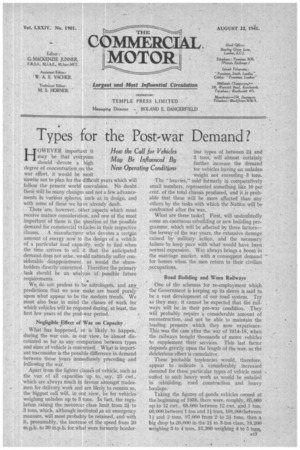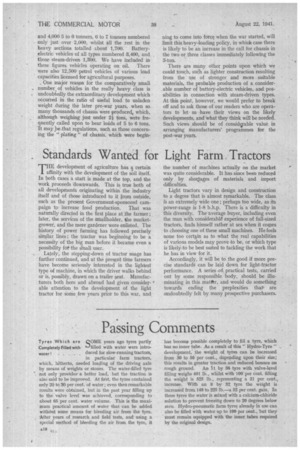Types for the Post-war Demand?
Page 19

Page 20

If you've noticed an error in this article please click here to report it so we can fix it.
HOWEVER important it may be that everyone should -devote a high degree of concentration on the war effort, it would be most unwise not to plan for the difficult years which will follow the present world convulsion. No doubt there will be many changes and not a few advancements in various spheres, such as in design, and with sonic of these we have already dealt.
There 'are, however, other aspects which must receive mature consideration, and one of the most important of these is the question of the possible demand for commercial -vehicles in their respective classes. A manufacturer who devotes a certain amount of energy no to the design of a vehicle of a particular load capacity, only to find when the time arrives to sell it that the anticipated demand dogs not arise, would naturally suffer conr siderabledisappointment, as would the shareholders directly concerned. Therefore the primary task should be an analysis of possible future requirements. • We, do not profess to be astrologers, and any, predictions that we now make are based purely upon what appear to be the modem trends. We must also -bear in mind the classes of work for which vehicles will be required during, at least, the first few years of the post-war period.
, Negligible .Effect of War on Capacity What has happened, or is likely to happen, during the war can, in our view, be almost discounted so far as any comparison between types and sizes of vehicle is concerned. What is important to.consider is the possible difference in demand between those Years immediately preceding and following the war.
Apart from the lighter classA of vehicle, such as the van of all capacities up to„ say, 25 cwt.,' which are always much in favour amongst trades . men for delivery work and are likely to remain so, the biggest call will, in our view, he for vehicles weighing unladen up to 3 tons. In fact, the regulation raising the motorcar class limit from 2 to 3 tons, which, although instituted ,as an emergency measure, will most probably be retained, and with it, presumably, the increase of the speed from 20 m.n.h. to 30 m.p.h. for what were formerly border line types of between 2i and 3 tons, will almost certainly further increase the demand for vehicles having an unladen weight not exceeding 3 tons.
.The "heavies," sold formerly in comparatively small numbers, represented something like 10 per cent. of the total chassis produced, and it is probable that these will be more affected than any others by the tasks with which the Nation will be confronted after the war.
What are these tasks? First, will undoubtedly come an enormous rebuilding or new building programme, which will be affected by three factors— the leeway of the war years, the extensive damage caused by military action, and the necessary failure to keep pace with what would have been normal expansion. War always brings a boom in the marriage market, with a conseuent demand for homes when the men return to their civilian occupations.
Road Building and Worn Railways One of the schemes for re-employment which the Government is keeping up its sleeve is said to be a vast development of our toad system. Try as they may, it cannot be expected that the railways will be in their pre-war condition. They will probably require a considerable amount of reconstruction, and not be able to maintain the loading, pressure which they now experience. This was the case after the war of 1914-18, when the railways bought thousands of motor vehicles to supplement their services. This last factor depends greatly upon the length of the war, as the deleterious effect is cumulative.
These probable tendencies would, therefore, appear to indicate a considerably . increased demand for those particular types of vehicle most -suited to such heavy work as would be entailed in rebuilding, road construction and heavy haulage.
Taking the figures of goods vehicles owned at the beginning of 1938. there were, roughly, 65,000 up to 12 cwt., 68,000 between 12 cwt. and 1 ton, 66,000 between 1 ton and 1i tons, 108,000 between 1 and 2 tons, 97,000 from 2 to 24 tons, then a big drop to 20000 in the 21 to 3-ton class, 18,200 weighing 3 to 4 tons, 13,200 weighing 4 to 5 tons,, and 4,000 5 to 6 tonners, 6 to 7 thrillers numbered only just over 2,000, whilst all the rest in the heavy sections totalled about 1,700. Batteryelectric vehicles of all types numbered 3,400, and those steam-driven 1,300. We have included in these figures vehicles operating on oil. There were also 12,500 petrol vehicles of various load capacities licensed for agricultural purposes.
, One major reason for the comparatively small number. of vehicles in the really heavy class is undoubtedly the extraordinary development which occurred in the ratio of useful load to unladen weight during the later pre-war years, when so many thousands of chassis were produced., which, although weighing just under 2i tong, wete frequently called upon to bear loads of 5 to 6 tons. It may Pe.that regulations, such as those concerning the " plating " of chassis, which were begin ning to come into force when the war started, will limit this heavy-loading policy, in whick case there is likely to be an increase in the call for chassis in the two or three classes immediately following the 3-ton.
There are many other points upon which we could touch, such as lighter construction resulting from the use of stronger and more suitable materials, the probable production of a consider. able number of battery-electric vehicles, and possibilities in connection with steam-driven types. At this point, however, we would prefer to break off and to ask those of our readers who are operators to Jet us have their views on the likely developments, and what they think will be needed. Such views should be of considsiable value in arranging manufacturers' programmes for the post-war years.




























































